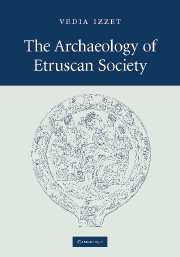Book contents
- Frontmatter
- Contents
- List of illustrations
- Acknowledgements
- List of abbreviations
- Introduction
- 1 Models of change in Etruria
- 2 Etruscan mirrors: reflections on personal and gender identity
- 3 Funerary architecture: the living and the dead
- 4 Sanctuaries: the sacred and the profane
- 5 Domestic architecture: public and private
- 6 Urban form and the concept of the city
- 7 Making Etruscan society: culture contact and (material) culture change
- Bibliography
- Index
4 - Sanctuaries: the sacred and the profane
Published online by Cambridge University Press: 10 May 2010
- Frontmatter
- Contents
- List of illustrations
- Acknowledgements
- List of abbreviations
- Introduction
- 1 Models of change in Etruria
- 2 Etruscan mirrors: reflections on personal and gender identity
- 3 Funerary architecture: the living and the dead
- 4 Sanctuaries: the sacred and the profane
- 5 Domestic architecture: public and private
- 6 Urban form and the concept of the city
- 7 Making Etruscan society: culture contact and (material) culture change
- Bibliography
- Index
Summary
Introduction
The previous chapter developed an account of Etruscan funerary architecture that demonstrated the importance of creating discrete and readily visible boundaries for the dead. In this chapter, a similar argument will be proposed for the physical and architectural setting of formal ritual practice. In the earlier period of Etruscan history, the locations of religious activity are difficult to perceive archaeologically; however, by the late sixth century it is possible to discern formal sanctuary complexes with architecturally discrete temples. This chapter examines this change in the treatment of ritual space by focusing on two aspects: first, the form and decoration of the temple; and second, the form of sanctuary complex. The stress here is on the planning and construction of temple architecture, with all the choices involved in how this should be accomplished. At every stage, alternatives (both well-established and innovatory) were available and decisions were made on how to move on to the next stage of the construction; every element in temple architecture was made deliberately, and the methods of construction were intentionally selected. As discussed in Chapter 1 this active process of selection applies to all material culture, and all aspects of the Etruscan ritual environment, from the location of the temple in the landscape to the details of the decoration of the gutter tiles. The manner in which objects or buildings are made, decorated or located is never arbitrary; they exist because they have meaning, and they occur in the form that they do because those forms have meanings.
- Type
- Chapter
- Information
- The Archaeology of Etruscan Society , pp. 122 - 142Publisher: Cambridge University PressPrint publication year: 2007



